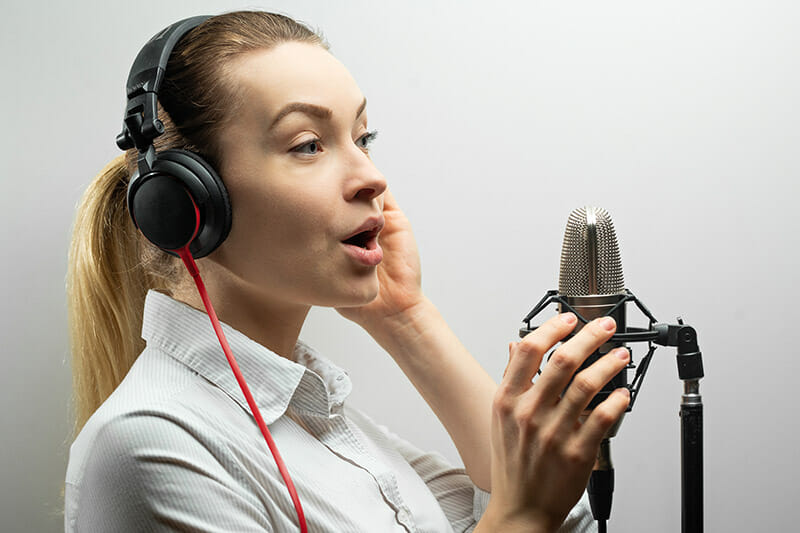You’re looking out over a sweeping landscape, mesmerized by the heights and gorgeous forest below you, when an epic, Morgan Freeman style voice booms out from somewhere behind the camera: “Nature… the great outdoors…”
This is called a voiceover, often abbreviated to V.O., and is one of the most well-known video production techniques. Whether used as a narration device, a shorthand tool for commercials, or as a comedic effect in countless TV shows, movies, and short-form videos, most people are familiar with the voiceover technique thanks to its prevalence in pop culture and media.
However, knowing what a voiceover is doesn’t mean you know how how to do it well. So, what makes a voiceover great? Do you plan a video around voiceover, or is it the other way around? When do you use voiceover instead of dialogue or music? How do you pick the right voice actor for your video’s voiceover?
We’re going to answer all of these questions below, so without further ado, let’s dive into the wonderful world of voiceovers!
How Do You Make Your Own Voiceover?
Have you ever tried to create and implement your own voiceover on one of your videos, but didn’t know how or when you should do it? For first-timers, it can be tricky to know how to put a voiceover together as part of your video. Here’s a quick step-by-step guide:
- Before you begin, script out your voiceover by writing down the words that will be spoken to go along with whatever visuals you are planning to shoot for your video. You should have a good sense of what you want to see while your voice actor is reading the lines, so the visuals will correspond with what’s being said.
- Then, you will film your video. One common mistake you might make is trying to record the voiceover in front of the camera while filming your video. The best part about voiceover is that you don’t actually have to record it while you are on-set.
- Instead, you record your voiceover as a separate audio track and apply it over the visuals during the editing process in post-production. That way, you aren’t limited to only using the visuals where the audio lines up. If you were, it would make your video very difficult to edit.
- To record your voiceover, you will hire your voice actor and book time in a recording studio. This can be a soundproof booth in your editing room, an actual mix-studio that’s part of a larger editing bay you rent out, or just a good microphone and audio recorder in a quiet part of your company office to record.
- Depending on how high-tech your booth is, you can either record the voiceover separately and overlay it onto the video once done, or you can play the video while your voice actor is reading, so your editor and director can sync up the audio and visuals in real time, making cuts to the script or giving direction on pacing in real time depending on what’s needed for the pace of the video.
- Once you have synced the voiceover audio with the video, you do your final mix, where you adjust the voiceover’s sound levels with the rest of the video’s sound tracks. These other soundtracks could be diegetic sound, audio recorded on-set that’s part of the story like an actor’s dialogue lines or special sound effects, or background music, which plays alongside the voiceover lines.
- Then, add any title screens, end credits, and subtitles, and finish your video!
What Makes a Voiceover Great?
A great voiceover will, first and foremost, emotionally communicate what your video is about. Whether it’s a narrator telling a story, asking the audience a question, or rallying a community to a cause, the voiceover should be passionate, clear, concise, and most importantly, true to the narrative.
For example, if your voiceover is just describing what is happening on screen without adding new context or details to what we are seeing, then it doesn’t belong in your video. Just describing what an audience can see themselves does not provide value to the video, and it’s why many first-time screenwriters and filmmakers are advised not to rely on or use voiceover at all to tell their stories.
The same is true for voiceover in video marketing videos. If your ad has a narrator or celebrity spokesman, that person’s voiceover should be important to the storytelling of the ad or video, not just explaining what people are seeing.
To put it simply, your voiceover be all about your video’s “WHY.” In the same way that your video should have a purpose to exist, your voiceover should have a purpose to exist in your video. This can be different depending on what goal you are trying to achieve and how you are using the voiceover.
For example, if your video’s script is the most important part, then you can use the accompanying visuals to underline certain key value points your voiceover is making.
Meanwhile, if your video’s visuals are the most important part of your ad, then your voiceover should be emphasizing and adding more context or extra details to what’s being seen on screen.

How Can You Plan Your Video Around Voiceover?
Simple: by writing your voiceover into the script.
As a rule of thumb, before you go out and shoot anything, you should script out what you want your video to look and sound like. This is good advice for almost every type of marketing video you shoot, even if you are just writing down the concept and certain visuals you want to see, but especially if you plan to include any voiceover.
For any time that you intend to use voiceover as a central part of your video, you should write it down ahead of time. As part of that same script, you should also write down any corresponding visuals you imagine would go along with said voiceover.
As an example, you don’t want to go out and film a bunch of shots of nature and have your voiceover be about how cheap and affordable your services are. And by contrast, you don’t want your video’s visuals to be all shots of your company’s processes in action when the voiceover is all about community and the importance of your customers.
By aligning the voiceover text with the visuals that go with it, you can streamline your entire video production process. You will already know what footage you need to capture on the day, and your assembly edit will be that much easier to put together because you’ve already mapped out the key movements, or structure, of how you want your video to flow ahead of time.
How Do You Know if Your Video Needs a Voiceover or Not?
There may be times where you are struggling to come up with voiceover for a certain video at the script level. Or you might be making one of the many video types we make for our clients that don’t require any voiceover at all, and as such, your video doesn’t actually need any pre-written voiceover.
In those instances, the use of voiceover should be dictated by the script. If you are writing a script with scenes in it where actors do all the talking, you most likely don’t need a narrator or voiceover, except if you are having a narrator come in at the end of the video to emphasize a key selling point or value proposition, which is totally at your discretion.
On the flip side of that, there may be times where you don’t write a voiceover into a script, but you find your video might need it later. Not every voiceover has to be written and planned out ahead of time. It’s usually better when it is, but there will be those times you just happen to have a bunch of good footage and you just need a little voiceover to assemble it all together in a cohesive manner.
This could happen if you go out and film some great footage on the day, but feel your video is missing some important context in the edit room. Like you’re trying to make an event video, and wanted to expand on what’s seen on screen by sharing how many people attended and why this event was important to your company.
How Do You Pick the Right Voice Actor?
Picking the right voice actor for your video is more about a voice’s feeling and tone than it is about that voice actor being the most talented or well-known. Obviously, some actors have better voices than others, but not all videos require epic narration of prestigious caliber. It all depends on the type of video you are creating.
For example, if your video has more of a laid back vibe, you might want a more chill, surfer-like voice to sooth your audience and bring them to your level. Or if you have a more intense workout product, you may want a manly, gruff sounding voice to get your viewers pumped about the benefits of your extreme brand of fitness! You might want a soft, bubbly voice to advertise a kid’s product, or an actual kid’s voice to communicate the genuine excitement of a cool new toy!
In voice casting, just like regular casting, it’s all about the attitude and tone that a voice can bring, and whether that fits with your video. You don’t need the best actor, just the one that fits the story or product the best.

How Will Artificial Intelligence Affect Voiceover Creation?
With AI-powered voice synthesis technologies, it’s becoming increasingly possible to generate high-quality, natural-sounding voices that can be used for narration, character voices, and other elements of video production. One major benefit of AI in voiceover creation is its efficiency. AI algorithms can quickly process and generate voice recordings, significantly reducing the time and cost associated with traditional voice recording sessions. This enables video producers to iterate and experiment with different voice styles and languages more easily, accelerating the overall production timeline.
However, despite the advantages, there are certain nuances of voice acting that can still only be accomplished by humans. Voice acting involves a range of skills beyond the ability to produce sound. Human actors bring a depth of emotion, interpretation, and understanding to their performances that is difficult for AI to replicate. They can capture subtle nuances in delivery, such as conveying complex emotions, adapting to specific character traits, or infusing their performance with references to pop culture cues that resonate with the audience. These human touches can add authenticity, charm, and relatability to a video production, making it more engaging and memorable for viewers.
Need An Extra Voice to Chime In?
At Lemonlight, we create videos with awesome voiceovers all the time. From writing to casting to recording and editing, working with high quality voiceovers for high quality videos is one of our specialties, and we’d love to help you no matter what stage you are in your video production process. Schedule an intro call now and we can help you get started right away!


